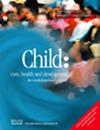Transitions of 24-H Movement Behaviour Profiles From Schooldays to Weekends and Their Associations With Health-Related Quality of Life and Well-Being in Czech Adolescents
Abstract
Background
Adolescents' movement behaviours (MB) vary between schooldays and weekends, potentially impacting health-related quality of life (HRQoL) and well-being. This study aimed to identify transitions between 24-h MB profiles on schooldays and weekends and examine their associations with HRQoL and well-being.
Methods
This is a cross-sectional study of 1070 Czech adolescents (average age: 13.8 years and standard deviation: 2.2 years; 56% girls). Participants wore accelerometers for 7 consecutive days to assess physical activity (PA) of different intensities, sedentary behaviour (SB) and sleep. A subsample of 451 participants provided data on HRQoL, which was measured using the Paediatric Quality of Life Inventory, and 484 provided valid well-being data measured with the 5-item World Health Organisation Well-Being Index. Latent transition analysis was used on the MB variables to identify transitions across MB profiles, and linear regression was used to examine associations between transitions and HRQoL or well-being.
Results
Four MB profiles were identified: Excellent (high PA, low SB and high sleep duration), Good (average MB values), Fair (below-average PA and sleep, above-average SB) and Poor (low PA and sleep, high SB). Most adolescents transitioned to less favourable profiles on weekends. Those remaining in the Excellent profile had higher HRQoL than those transitioning to less favourable profiles. Transitions to the Poor profile were associated with the lowest HRQoL and well-being scores.
Conclusion
This study underscores the dynamic nature of adolescents' MB and the importance of consistent, healthy routines. Interventions optimizing 24-h MB throughout the week and especially on weekends may enhance adolescent HRQoL and well-being, but further evidence from longitudinal and intervention studies is needed.
Summary
- We observed a contrast in 24-h MB between schooldays and weekends: 29.7% of adolescents were in the Excellent on schooldays, but only 5.8% did so on weekends, while the prevalence of the Poor profile rose from 1.6% on schooldays to 27.7% on weekends.
- Adolescents who maintained the Excellent profile across the whole week recorded the highest scores for HRQoL and well-being.
- Moving into the Poor profile on weekend was associated with about 9 points poorer HRQoL and 14 points lower well-being, compared with peers who remained in the Excellent profile.
- Behaviour change strategies should target the entire week to preserve PA, reduce SB and protect sleep.

 求助内容:
求助内容: 应助结果提醒方式:
应助结果提醒方式:


